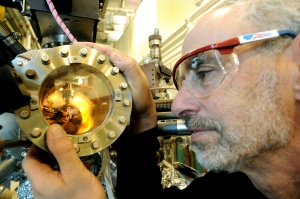Nov 29 2008
The basic molecules that make up all living things have a predetermined chirality or "handedness," similar to the way people are right- or left-handed. This chirality has a profound influence on the chemistry and molecular interactions of living organisms. The creation of chirality from the elementary building blocks of matter is one of the great mysteries of the origin of life. Scientists at the U.S. Department of Energy's Argonne National Laboratory have discovered a way to induce this handedness in pre-biological molecules.
 Argonne chemist Richard Rosenberg examines source material for an experiment to induce chirality into pre-biological systems at the Advanced Photon Source. Rosenberg used X-ray photoelectron spectroscopy to measure the secondary electron induced photolysis reaction rate of a model chiral compound adsorbed on a magnetic substrate. He found that changing the magnetization direction in relation to the high-intensity X-ray beam created an excess of one chirality over another.
Argonne chemist Richard Rosenberg examines source material for an experiment to induce chirality into pre-biological systems at the Advanced Photon Source. Rosenberg used X-ray photoelectron spectroscopy to measure the secondary electron induced photolysis reaction rate of a model chiral compound adsorbed on a magnetic substrate. He found that changing the magnetization direction in relation to the high-intensity X-ray beam created an excess of one chirality over another.
"Understanding how the molecules necessary for life originated is one of the most basic scientific questions in biochemistry," said Argonne chemist Richard Rosenberg. "Chirality plays a fundamental role in biological processes, and researchers have been trying for years to discover the mechanisms that led to this property."
Rosenberg used X-rays from the Advanced Photon Source to bombard chiral molecules adsorbed on a magnetic substrate and X-ray photoelectron spectroscopy to track changes in their molecular bonds.
He found that changing the magnetization direction in relation to the high-intensity X-ray beam created an excess of one chirality over another. Changing the magnetization direction reverses the spin polarization of the secondary, or low-energy, electrons emitted from the substance.
Iron is a common element and is magnetic in many forms, and ionizing radiation and magnetic fields are prevalent throughout the universe.
Based on the Argonne results, it is conceivable that chirality could have been introduced by irradiation of molecules as they traveled through the universe while adsorbed on a magnetized substrate in a dust cloud, meteor, comet or on a primitive planet.
"Our study shows that spin-polarized secondary electrons interacting with chiral molecules could produce a significant excess of a given chirality in pre-biological molecules," Rosenberg said.
Argonne funded this research, which made use of a beamline at the Advanced Photon Source, an advanced X-ray light source built and funded by the Office of Basic Energy Sciences in the U.S. Department of Energy's Office of Science and used for advanced energy and materials science research.
A paper on Rosenberg's work appeared in a recent issue of Physical Review Letters.